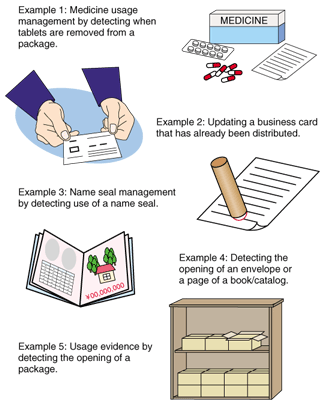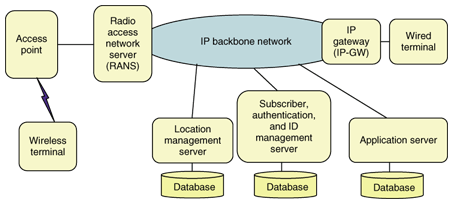 |
|||||||||||||||||||||||||||||||||||||||||||
|
|
|||||||||||||||||||||||||||||||||||||||||||
|
Selected Papers: Wide Area Ubiquitous Network Vol. 6, No. 3, pp. 9–13, Mar. 2008. https://doi.org/10.53829/ntr200803sp1 Wide Area Ubiquitous Network: New Wireless Network for Sensors and ActuatorsAbstractThis paper introduces the concept of a new wireless network infrastructure called the wide area ubiquitous network (WAUN). In this network, each cell has a wide coverage and can accommodate many low-power-consumption low-capability terminals, which can work as sensors and actuators. Examples of new applications that WAUN should support are shown and the features of WAUN are discussed. This paper also describes the importance of long-range wireless access with low-power transmission as a basic principle for the design targets of WAUN.
1. IntroductionA wide area ubiquitous network (WAUN) is a concept for a new wireless network infrastructure. In this network, each cell has a wide coverage and can accommodate many low-power-consumption low-capability terminals, which can work as sensors and actuators. Similar concepts, such as computers located anywhere in the TRON project and ubiquitous computing were advocated by Ken Sakamura [1] and Mark Weiser [2], respectively, in the 1980s. These concepts have now become achievable targets as a result of recent developments in electronics, micromechanics, and telecommunications (mainly wireless technologies), and there are many projects in which numerous small computers embedded in devices are distributed to perform some services as feasibility demonstrations. For example, the Japanese government has formulated a “u-Japan” plan and is launching a “u-Japan” program to achieve the objectives of the plan, where “u” means ubiquitous. By using ubiquitously networked small computers, including sensors and actuators, we can be networked anywhere and anytime with anybody and anything and can enjoy a convenient life [3]. The number of such small computers embedded in devices is expected to be huge and their size is expected to be tiny. Though one device cannot do very much, we expect such devices to do a lot if they are networked. The feasibility of such concepts strongly depends on recent developments in network technology, and the implementation of these concepts seems to require a new network in which devices are used as terminals. However, it is unclear what this network should be. This paper considers scenarios in which a huge number of devices, far more than the existing number of personal computers and cellular phones, are networked. In such circumstances, most of the terminals will be low-capability and low-performance ones because otherwise the total cost of the terminals would be extremely high. The main aim of this paper is to discuss what kind of network NTT, as a network provider, should offer for such low-end terminals [4]. 2. ApplicationsWhat are the applications for the scenario that we consider here? That is, what applications are possible in an environment where many low-end low-power-consumption terminals are deployed. The following ideas are currently at the stage of recently introduced commercial services or commercial trials in Japan.
In addition to applications such as these that have already been proposed, we think that much simpler devices will be networked for new applications and that the number of such devices will be much larger than the number of terminals for the initial applications. Some examples of such new applications are given below and illustrated in Fig. 1 [5].
These new applications are used with commodities that have never been networked and can be implemented by very small simple sensors or actuators that are networked. Although these terminals are very low-end ones and do not need high transmission rates, these applications will result in an extremely large number of terminals. In addition, these terminals may be treated as expendable, being used once and then discarded. 3. Wide area ubiquitous networkA promising approach for implementing ubiquitous connectivity is to organize local networks with multihopping and ad-hoc networking wireless mobile nodes equipped with short-range wireless devices such as ZigBee, a wireless local area network, or Bluetooth. However, some applications need connectivity in public areas or outside the user's home/office. In such situations, this approach causes technical issues such as the power consumed when a wireless mobile node is used as a mobile switching node, the security threat to mobile switching nodes, and an unstable service area or routing due to too many mobile nodes having excessive freedom of movement. Thus, we have concluded that WAUN should provide long-range wireless access. If the range is longer than a few kilometers, we can make full use of existing assets. This is because existing local network operators have their own buildings every few kilometers and those buildings have communications and power supply cables on their roofs. Therefore, we can put antennas on the tops of these buildings without additional cable costs. In addition to a wide coverage area with low-power-consumption terminals, in order to support the creation of a ubiquitous networked society, WAUN must satisfy at least the following requirements: scalability regarding the number of terminals, terminal mobility, support for low-capability terminals, security, economy, and provision of environments for easy development of new applications and collaboration with existing services such as Web services. Therefore, our WAUN project is conducting research to satisfy all these requirements. Middleware functions, which are expected to resolve some of the problems, are discussed in section 4. The features of WAUN are as follows (Fig. 2).
4. Middleware functionsWAUN offers basic capabilities for collecting sensory data and transmitting actuator commands. If the wireless terminal has sufficient CPU performance and memory, users have the ability to develop applications, and the wired IP terminal can work as a server, so the basic capabilities of WAUN may be sufficient. However, this will often not be the case. Thus, WAUN middleware is provided to compensate for this situation. The middleware eases the development of applications by being introduced in wireless terminals and wired IP terminals as well as offering users higher-layer platform services by being introduced in wireless terminals and application servers within WAUN. Higher-layer platform services may include (1) receiving and accumulating sensory data sent by wireless terminals, (2) searching for and finding target sensory data in the accumulated sensory data, (3) distributing the sensory data sent from a wireless terminal to a destination registered by the user or according to logic programmed by the user, and (4) downloading actuator commands to the wireless terminal associated with the actuator through the user program. Such higher-layer services mean that the user need not set up servers to receive data from the wireless terminals or provide programs that can be accommodated in the wireless terminal, which has limited memory and CPU performance. Higher-layer services may also be useful for anonymously, offering sensory data obtained by one user to another user. A mediation service among the higher-layer services receives sensory data obtained by a user and sends it to another user while hiding the identity of the user who provided the original data. This service is useful for secondary use of sensory data because it can conceal private information. 5. ConclusionsI introduced the concept of a wide area ubiquitous network (WAUN). To support new applications with simple terminals economically, it has large cells, low-power-consumption protocols and terminals, and middleware. The other Selected Papers in this issue provide additional details about WAUN. References
|
|||||||||||||||||||||||||||||||||||||||||||











